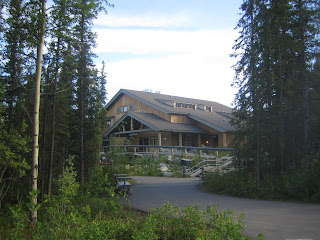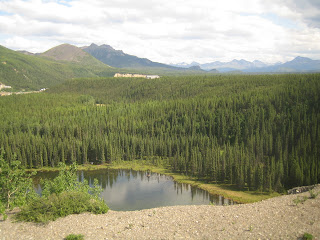They're not what you think.
So, you get on a shuttle-bus to go deeper into the park. You're welcome to get off the but at any point along the road, stay as long a you like, and go wherever you want. You just ask the driver to stop and let you off. Then, whenever you're ready, you can get on the next bus going either direction, and continue your journey. With no existing trails, however, it seems that very few people actually go out onto the tundra. One of the bus drivers told us that probably 90% of the people that take a shuttle into the park never even leave the side of the road. Without the Discovery Hikes, or "Disco Hikes", I probably would have fallen into that vast majority.
For a fee of $32.00, the park offers a handful of Disco Hikes each day. Each hike is led by a park ranger, and is limited to 11 people on a first-come/first-served basis. There are different degrees of difficulty and distances covered, so, you get to pick your poision, and you have to bring all of your own food and water for the day. I chose a 5-mile round-trip hike to the top of Cathedral Mountain, which has an elevation gain of about 2,000 feet. It was labled as a "strenuous" 6-hour hike, which I now think was a bit kind.
Starting point for our climb
We had 7 people in our group, including Ranger Michael, who has been with the park for about 20 years. Our shuttle left the WAC at 8:00 am, and at about mile-34, Michael told the bus-driver that this would be a fine spot for us get out. So the driver pulled to a stop, let us out, and then drove on down the road. Without hesitation, Michael said "let's go in for a few hundred yards, then we'll stop and go over our plan for the day".
I've never walked on tundra before. We started out on what is called "wet" tundra. For the most part, the tundra is just open land that's covered in several inches of low-rising shrubbery, ferns, moss, and liechen. From a distance, it doesn't look any different than a typical pasture or meadow. But it's very thick, kind of springy, and walking on it feels like you're walking on a lumpy mattress. Very different that anything I've hiked on before. Where we left the road, every footstep sank about 6 to 8 inches into the stuff. The layer of tundra acts as insulation over the perma-frost. During the summer, the very top of the perma-frost warms up, turns to muck, and there you have your "wet" tundra. It's not easy to hike through.
A level picture to show the grade
Once we stopped, the first thing that Ranger Mike said was, "statistically speaking, we shouldn't encounter a bear". In Denali, a bear has never engaged a group of 6 or more people, probably because the group just makes too much noise. Smaller groups, especially 1's and 2's, generally don't make enough noise, and can suprise a bear, which is obviously not good. But, nobody has ever been killed by a bear in the park, and they attribute that to certain practices that I'll describe later. Nonetheless, Ranger Mike emptied his back-pack, showed us his first-aid kit, and how to work his radio and satellite phone in the event he became "incapacitaed". He also asked if anyone had any medical training. Nice.
Ranger Mike said that every time they do a Disco Hike, they try to make sure that they don't go to the same place twice in the same season, or, at least never use the same route twice. So, while he knows where we're going, this is going to be a new hike for him also, and there's a pretty fair chance that our route is going to cover some land that's never been walked on before. After a radio-check with the ranger station confirming our entry point, destination, and the number of people in our group, we started our way up the base of the mountian.
The summit of Cathedrial Mountian is at 4,905 feet, and the base of the valley where we began is at about 3,000 feet. So, it's just short of 2,000 feet of elevation gain. The slope is reasonable at first, and while walking across the open tundra, we are istructed to separate and NOT follow each other so that we don't even begin to create a trail. When we get to the thicker brush and 8 to 10-foot willow trees, we all come together and start following the existing game trails - trails that have been created by the forraging moose and bear - first, because it's easier and second, because we still don't want to create new trails. Here, where we can't see much more than what's right in front of us, we start calling out "hey bear" or "hey moose" every 15 or 20 seconds, just to make sure that we don't surprise someone.
We came across both moose-skat and bear-skat on the game trails, and it's important to be able to know one from the other, and recognize how old it is. It's good to know whether it came from a moose last week, or a bear last night. We found two-week-old bear-skat that contained a partially digested rabbit foot at one spot, and fresh moose-skat at another. If the bear-skat was as fresh as the moose-skat, Ranger Mike said that he would have been just a little bit nervous.
Ascending above the heaver brush, we entered onto the "alpine" tundra. It's much thinner than the wet tundra, so you don't sink-in as much and it's a lot easier to walk through. And here, we came upon a "bear dig" (below). Ranger Mike said that a bear will chase a burrowing animal into its hole, then just use its brute strenght and sharp claws to rip up the earth until he finds his lunch. He examined the dig and estimated that this was probably once home to the rabbit who's foot we found in the bear-skat below. Tough way to go, huh?
A "bear dig"
The picture below is looking the other direction from the bear dig. If you knew what to look for, you could see Mt. Healy, just left of center and behind the green mountians in the foreground. It's 34 miles away, where Camp Riley and the park entrance are located. Not a bad spot for a bear to have some lunch.
About half way up, we found a flat spot, and stopped to have lunch ourselves.
Lunch spot
The mountain in the picture below is across the valley and about 3 miles away from where we stopped for our break Near the top left is a small herd of Dall Sheep (little white specks, if you enlarge the picture - there's a long fang-like shadow on the mountain, left of center, and the sheep are in the smaller dark shadow right above that). These sure-footed creatures live at the top of the mountain peaks to avoid preditors, but eagles have been know to make a meal out of them by crashing into them and causing them to fall to their death. Kind of makes you wonder if it's better to be a Dall Sheep or a rabbit. We saw several golden eagles there in the park, and I saw one bald eagle on the train to Fairbanks.
Dall Sheep on the mtn. across from our lunch spot
The last several hundred feet of the climb were incredibly steep. This is Ranger Mike, and you can just make out another hiker coming up behind him. All you can see is the top of his head, which is below him and to the left. Like I said, it's really steep.
The view from the top was spectacular. Note the shuttle bus down on the road in the bottom right of the picture below.
Northern view from top of Cathedral Mtn.
Western view towards Mt. McKinley
Southern view towards Anchorage
In the picture above, I'm back down at our lunch spot, and looking up toward the top of Cathedral Mtn. If you enlarge the picture, you can probably see a few of the other hikers who are still on their way down. They're in the center near the top. The slope is so steep that you have to serpentine all the way up and down.
The beauty of the Disco Hike is that it gets you out into the wild. I probably would not have attempted something like this on my own, but having a ranger lead a small group is a perfect combination that lets you take on this challenging kind of hike safely. I learned so much from Ranger Mike on this trip that I started thinking about going out into the wilderness on my own. I quickly realized, however, that at least on this trip, I was lugging around way too much unnecessary stuff (like a folding chair, a big air mattress, too many clothes, etc.). And to top it off, my tent was way to big to take down, re-pack, lug around all day, and set up again every evening. So, I started a new list for my next trip to REI store.

I think that I was out in the park for about 12 hours on this day. Of course, just because you're out in the wilderness doesn't mean that you can't have a decent meal. I treated myself to this nice salmon dinner at the park grill after the hike. The restaurant is located next to the visitor's center.
A just reward after a long day
The Park Grill
Other than eating at the grill, there's a small convenience store at the campground where I could buy some groceries - canned soup, chili, jerkey, trail mix, etc. One of the coolest gadgets that I bought at REI is this green "Jet Boil" stove system. The whole system, including fuel, packs down into the cooking vessel (very bottom picture, and note the sunglasses and 1-liter water bottle for scale). It starts with a spark-switch, so you don't even need a match, and it will boil water in about 2 minutes. I started most days with a cup of that Starbucks "Via" freeze-dried coffee, and would then heat up a can of chili for breakfast. I could do the whole meal, start to finish, in about 15 minutes, and then be ready to hit the trail.
My new stove - perfect for wilderness camping
Wilderness camping is allowed in Denali, or perhaps I should say that it is even encouraged. Basic rules are that you pack everything in AND out (including used toilet paper), no fires (but camp stoves are OK), no guns, your campsite cannot be visible from the park road, and you should not use a campsite that was previously made by someone else. You have to check in at the WAC, get a backcountry permit, file a plan and then discuss it with the rangers, and they will lend you a bear-proof food container. The park is divided into about 90 units of various sizes, and they tightly control the number of campers that are allowed in any unit at any one time. They allow only 2 or sometimes 4 wilderness campers in the smaller units (40,000 to 50,000 acres per unit) and maybe 10 to 12 campers in the larger units (80,000 to 90,000 acres per unit). So, chances are that once you leave the road, you and you're group are not going to see another person until you return.



















































